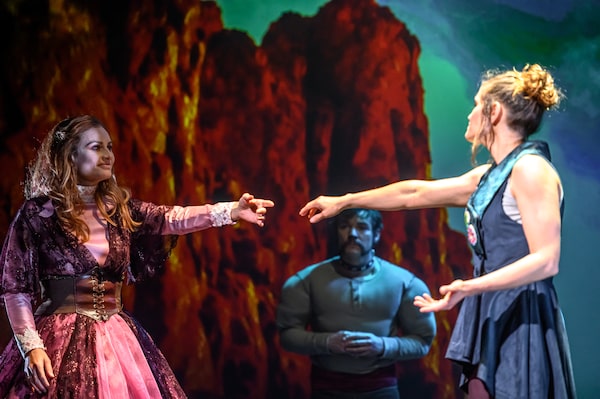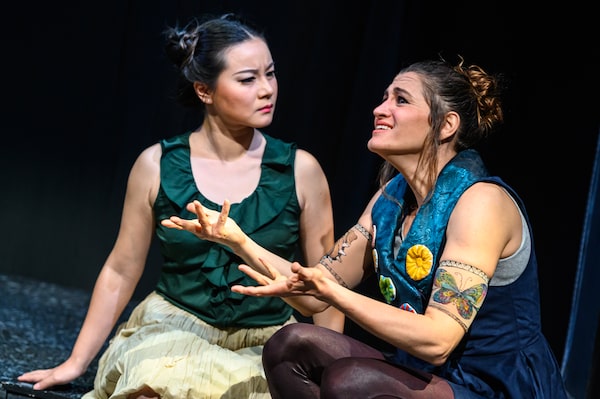
Contrary to what hearing theatregoers may think, “Deaf musical” is not an oxymoron.Dahlia Katz
- Title: The Black Drum
- Written by: Adam Pottle
- Director: Mira Zuckermann
- Actors: Dawn Jani Birley, Bob Hiltermann
- Company: Canadian Cultural Society of the Deaf in association with Soulpepper
- Venue: Young Centre for the Performing Arts
- City: Toronto
- Year: Runs to June 29, 2019
What is music?
The Black Drum, a new “Deaf musical” now on at Soulpepper theatre, asks the question in both its unusual form – and its fantastic story about a Deaf woman who fights despair and death incarnate by believing in her own singular musical talent. (The artists involved capitalize “Deaf,” so I will as well.)
“Deaf musical” may sound like an oxymoron to some hearing theatregoers, but there are plenty of examples of Deaf-inclusive musical-theatre productions. Notably, California’s Deaf West Theatre has brought shows such as Spring Awakening to Broadway with Deaf lead actors shadowed on stage by singing actors, double-vision productions that have entertained audiences of all abilities.
Written by the Deaf Canadian playwright Adam Pottle, The Black Drum considers itself something entirely different – “the world’s first entirely Deaf musical that is not originally a sound-based work”.
A Canadian Cultural Society of the Deaf production, supported by one of the Canada Council’s sesquicentennial Next Chapter grants, the show’s plot is like The Wizard of Oz crossed with Orpheus and Eurydice.
Joan (played, movingly, by the Toronto Theatre Critics Award-winning actress Dawn Jani Birley) grieves the death of her wife, Karen (Agata Wisny), so keenly that one day she is sucked into the “In Between” where her late love now exists.

The Black Drum climaxes with a group number that combines vibration, projected colour and stuttered choreography.Dahlia Katz
The projection-screen walls of designer Ken MacKenzie’s pull back to reveal this secret purgatory. It is a black-and-white world where music, laughter, love and freedom are all forbidden and Karen is controlled, like a marionette without strings, by the evil Minister – played by the towering Bob Hiltermann, somehow both frightening and charismatic in pale makeup, black robes and platform boots.
In the In Between, Joan finds that her arm tattoos of a Butterfly (Yan Liu) and a Bulldog (an amusing Daniel Durant) have come to life. These creatures are played by the same actors who earlier were her neighbours in the real world, reinforcing the Dorothy-like nature of Joan’s journey. (Tattoos, we’re not in Kansas anymore!)
Following the monochrome road to Karen, Joan makes more friends: Eager Ava (Corinna Den Dekker), who takes care of a trio of dancing children straight out of Edward Gorey (played by three, young Deaf ballet dancers); and Squib (Natasha C. Bacchus), a minion of the Minister’s ripe for rebellion.
Joan eventually has a showdown with the Minister – who like an ASL Sith can throw characters, or make them crumple with a single signed gesture. But our unhearing heroine has a secret weapon: Her soundless song.
The climax of The Black Drum is certainly unlike anything I’ve ever seen before – a group number combining vibration, projected colour and the unnerving, stuttered choreography of Patricia Allison. The music, here as elsewhere in the show, is an accentuated, exaggerated type of signing that verges on dance.
As for what I heard: From the side of the stage, a drummer (Dimitri Kanaris) beats a giant drum hard enough that you can feel it in your body. If the drumming seems slightly out of sync with the actors, this is because he is following their movements. The performers are not dancing to the drum; the drummer is drumming to the dance.

The audience is brought up to speed on the plot through recordings.Dahlia Katz
There’s also a deep drone from the speakers that makes the seats and lighting rig rattle.
As a hearing theatregoer, I wish I had brought ear plugs. There’s plenty to admire visually in the big, broad, physical performances elicited from this international cast by director Mira Zuckermann, who runs Teater Manu, the only professional sign-language theatre in Norway.
I was particularly captivated by Hiltermann’s stylized sinister movements as the Minister – and could easily understand the lyrics, if the word is appropriate here, to his signed song Black Heart about a world without joy.
I felt Birley’s strong sense of loss as Joan, but I was unclear as to what was happening moment to moment on her journey. The nuances of Pottle’s writing, whatever they may be, went over my head.
The audience (a word that implies hearing or listening, as opposed to spectator) gets updated on the plot every so often through curt, matter-of-fact recordings. There’s definitely a sense of the artistic team’s desire to reverse the regular design of things here: To “interpret” a show for the hearing, rather than fully include them. I couldn’t say what Deaf spectators will get out of The Black Drum, which I found fascinating but, literally, not for me.
Live your best. We have a daily Life & Arts newsletter, providing you with our latest stories on health, travel, food and culture. Sign up today.
 J. Kelly Nestruck
J. Kelly Nestruck